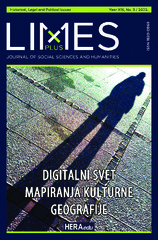Приказ основних података о документу
Istrajnost slikovitog pamćenja: foto-arhiv umetnika u digitalnom dobu
Persistence of pictural memory: photo archives of artists in the digital age
| dc.contributor | Medin, Dušan | |
| dc.creator | Jokanović, Milena B. | |
| dc.date.accessioned | 2023-02-01T19:13:59Z | |
| dc.date.available | 2023-02-01T19:13:59Z | |
| dc.date.issued | 2022 | |
| dc.identifier.issn | 1820-0869 | |
| dc.identifier.uri | http://reff.f.bg.ac.rs/handle/123456789/4230 | |
| dc.description.abstract | U radu se analizira fenomen foto-arhiva umetnika u doba digitalne fotografije i novih medija. Naime, poslednjih nekoliko decenija sve je prisutnija pojava posebne vrste umetnika koji sakuplјa stare fotografije i od njih kreira svojevrsne arhive. Poput modernih šetača, prolazeći kroz gradske pejzaže, ali i kroz buvlјe pijace i gomile smeća, gde pronalaze različite objekte, ovi umetnici sakuplјaju bačene fotografije, svedočanstva ličnih sećanja prepuštena zaboravu. Sama estetika odabranih slika, najčešće u crno-beloj tehnici, razvijenih na foto-papiru ili kartonu, s pohabanim ivicama, otkrivajući slojeve prašine, zajedno sa impulsom za čuvanje i arhiviranje, sugeriše umetnikovu želјu da se odupre tehnološkom razvoju i neumitnom napretku. Intervencijama u okvirima svojih foto-arhiva umetnici daju novo značenje prikuplјenim slikama. One, nakon što su izgubile primarne vlasnike, tako postaju osnova za dalјa tumačenja, rekontekstualizaciju i rekategorizaciju. Međutim, kada u svoja dela uvode segmente kreiranih foto-arhiva, umetnici se često izražavaju kroz nove medije, namećući tako pitanja odnosa kulture sećanja koju analogna fotografija sredine 20. veka prikazuje i današnjih digitalnih prostora umetnosti i sećanja, te pitanja transmedijalne percepcije posmatrača. Analizom primera foto-arhiva umetnika Vladimira Perića, s kojim je za potrebe ovog istraživanja obavlјen opsežan intervju, ilustruju se uspostavlјene teorijske premise i ispituju istrajnost i moć medija analogne fotografije, odnosno sposobnost ovih slika prošlosti da opstanu u eri digitalne transformacije. Stoga se istraživanje oslanja na istoriju fotografije i modernu i savremenu istoriju i teoriju umetnosti u kontekstu umetničkih kolekcionarskih praksi, kao i teoriju (novih) medija, te doprinose kulturi sećanja i istoriji kolekcija. | sr |
| dc.description.abstract | Тhis paper analyzes the phenomenon of artists’ photo archives in the modern age of digital photography and new media. The last two decades have seen the rise of a special type of artist who collects old, analog photographs and creates particular archives. Like modern walkers, strolling through the city, but also through flea markets and garbage piles, where they collect various objects, these artists collect disposed old photographs, witnesses of personal memories left to oblivion. The very aesthetics of selected images, most often in black and white, developed on photo paper or cardboard with already eroded edges revealing layers of dust, together with the impulse to store and archive, suggest the artist’s desire to resist technological development and inevitable progress. By intervening in their photo archives, artists give new meanings to collected images. These witnesses of personal memories, having lost their primary owners, become the basis for further interpretations, recontextualization and recategorization. However, when appropriating segments of created archives in their works, artists often express themselves through new media, thus raising questions about the relationship between the culture of memory that analog photography of the mid-twentieth century depicts and today’s digital spaces of art and memory, and transmedia perception of the observer. By analyzing artists’ statements about the need to create collections of old photographs and examples of their interpretation in art, we examine the persistence of the medium of analog photography, i.e. the ability of these images of the past to endure and continue their lives in the age of digital transformation. Therefore, we rely on the history of photography and the modern and contemporary art history and theory in the context of artistic collecting practices, and the (new) media theory on the one hand, and contributions in the field of culture of memory and collections’ history, on the other. The analysis of the selected case, the photo archive of the artist Vladimir Perić, with whom a detailed interview has been conducted for the purposes of this research, illustrates the above theoretical premises. | sr |
| dc.language.iso | sr | sr |
| dc.publisher | Hera.edu | sr |
| dc.rights | openAccess | sr |
| dc.rights.uri | https://creativecommons.org/licenses/by/4.0/ | |
| dc.source | Digitalni svet mapiranja kulturne geografije, LIMES plus: journal of Social Sciences and Humanities | sr |
| dc.subject | foto-arhiv | sr |
| dc.subject | sećanje | sr |
| dc.subject | pamcenje | sr |
| dc.subject | digitalna era | sr |
| dc.subject | nadjeni objekat | sr |
| dc.subject | photo archive | |
| dc.subject | collection | |
| dc.subject | memory | |
| dc.subject | found object | |
| dc.subject | digital age | |
| dc.title | Istrajnost slikovitog pamćenja: foto-arhiv umetnika u digitalnom dobu | sr |
| dc.title | Persistence of pictural memory: photo archives of artists in the digital age | sr |
| dc.type | article | sr |
| dc.rights.license | BY | sr |
| dc.citation.epage | 123 | |
| dc.citation.issue | 3 | |
| dc.citation.rank | M51 | |
| dc.citation.spage | 97 | |
| dc.identifier.fulltext | http://reff.f.bg.ac.rs/bitstream/id/10245/bitstream_10245.pdf | |
| dc.identifier.rcub | https://hdl.handle.net/21.15107/rcub_reff_4230 | |
| dc.type.version | publishedVersion | sr |
| dc.identifier.cobiss | UDK: 77.03:930.25 |

